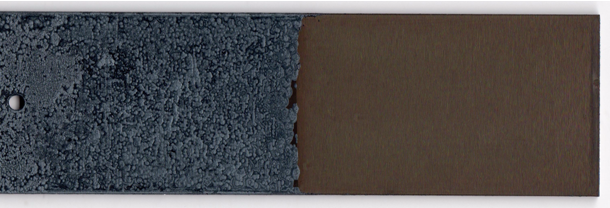In short – the thermal oxides formed after Minimox® treatment have:
1. Better surface chemistry
410 stainless steel. Recommended maximum service temperature for continuous exposure in air = 620°C (1150°F). Partially treated sample below was heated to 850°C for 30 hours.

Left: Untreated and oxidized 410 stainless. Thermal oxide is thick, flaking Fe2O3.
Right: Minimox-treated and oxidized 410 stainless. Thermal oxide is thin, adherent Cr2O3 + Cr-Mn-O spinel, even though there is no Cr or Mn in the solution.
2. Better surface structure – no flaking or protrusions



- The composition of the protective layer is primarily a function of the alloy, not the coating material. For example, the protective layer that forms on aluminum alloys is different from the protective layer that forms on stainless steels.
- The temperature of oxidation is set by the alloy, not by any Minimox solution requirements.
